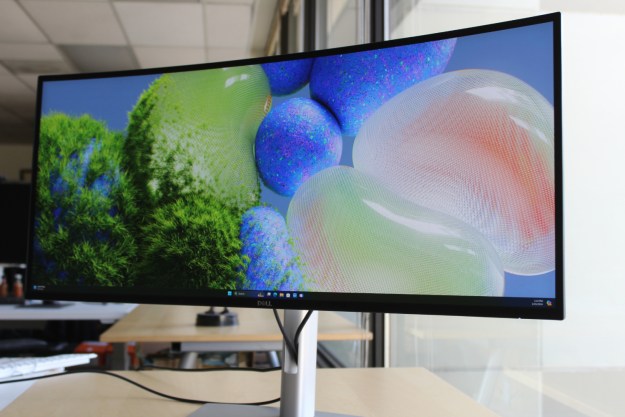
“The Dell UltraSharp 34 USB-C Monitor is an ultrawide monitor that's a great fit for the modern workspace.”
- 120Hz refresh rate
- Great contrast
- Surprisingly good speakers
- Excellent port selection
- KVM switch
- Three-year warranty
- Too expensive
- Needs to be calibrated
- Not super sharp
In just this past year, gaming monitors have enjoyed a successful jump to OLED. The technology is maturing, there are choices aplenty, and prices have even begun to drop.
But in the world of productivity- and creator-based monitors, the choices remain a bit more stagnant. Dell has hoped to entice buyers with its IPS Black technology, which enhances contrast above standard IPS panels. Combined now with a faster 120Hz refresh rate, and it’s time for a refresh.
That’s the Dell UltraSharp 34 Curved Thunderbolt Hub Monitor (U3425WE), a curved ultrawide monitor for productivity and creators. It comes with all the bells and whistles, making it for serious productivity junkies only. But there’s lot to praise, especially with the addition of the faster refresh rate.
Specs and pricing
| Dell UltraSharp 34 (U3425WE) | |
| Dimensions | 32 x 9.3 x 15.5 inches |
| Resolution | 3440 x 1440 |
| Curve | 1900R |
| Refresh rate | 120Hz |
| Panel type | IPS Black |
| Viewing angles | 178 degrees |
| Speakers | x2 5-watt speakers |
| KVM switch | Yes |
| Price | $1,020 |
The U3425WE costs $1,020, which is an eye-watering price compared to what else you can get for that money. Competitors like LG and Samsung don’t have an exact competitor to it out on the market, but they have pretty close options for well under $1,000. Take the 2020 LG 38WN95C Ultrawide, for example. It uses a brighter panel, faster at 144Hz, has similar port options, and is currently selling for just $850. According to LG’s website, it originally sold for $1,600, but I don’t know how long it sold at that price.
For pricing comparisons, it’s also worth considering the lower-priced version of this same monitor from Dell, the U3423WE. This display is identical in almost every way, including having the same resolution IPS Black screen, the same exact design, and all the same ports and features. The only thing missing is the 120Hz refresh rate.
Dell says it will continue to be sold and is currently goes for $736. Is the jump from 60Hz to 120Hz worth $284? I’m not sure that it is, but that’s a big question when it comes to the value this monitor offers.
Design
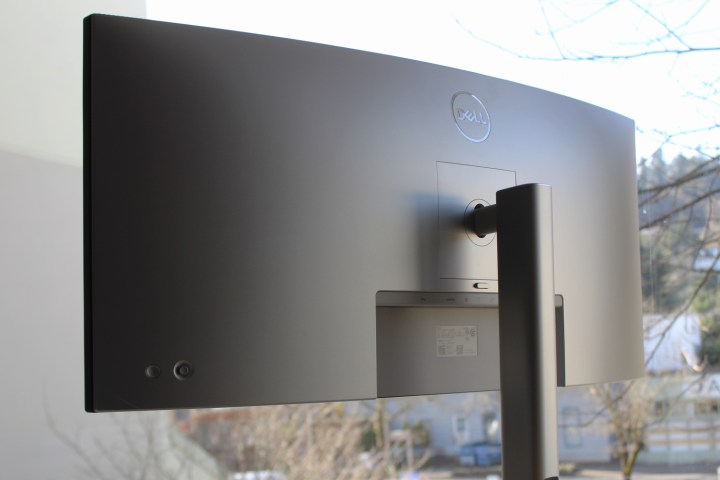
UltraSharps are premium in features and image quality, but lookers they are not. It’s not that they’re ugly — they’re just fairly basic. And a little clunky. To be fair, that’s what many business and home office users are looking for in a monitor – something that blends in with the environment and doesn’t draw too much attention.
As mentioned, it’s identical in design to the U3423WE and most of the other UltraSharp monitors.
That’s not a bad thing necessarily, but when you’re spending this much on a monitor, it’d be nice for it to be made of better materials or have a cleaner design. Dell ventured into sleeker designs in the past, but this form factor requires a fairly large stand and base. It’s a thick screen too. I can’t say the competition is all that more compelling though. I think the look of Samsung’s ViewFinity models are a bit classier, but the all-silver look of the UltraSharp gets the job done.
A big draw, obviously, is the curved, ultrawide screen. The 1900R curve is quite subtle, especially if you’re used to the more aggressive curves found on gaming monitors. This one wraps around you gently, providing the slightest sense of immersion and ensuring the width of the screen feels comfortable.

Setting up the UltraSharp couldn’t be simpler. The stand connects to the base with a few tightens of a screw, and the stand snaps into the VESA adapter on the back of the panel. At 25 pounds, it’s fairly light to maneuver and set up.
As is true of all 21:9 ultrawide monitors, the base is quite large, taking up a healthy amount of space on your desk to support the full movement of the monitor. The VESA adapter on the back makes it easy to swap it out for a different solution, fortunately. If you are using the stand and base, though, there’s a decent amount of adjustment to help find a comfortable position.
It takes a bit of muscle to get it moving, but it can height adjust 5.9 inches or swivel by 30 degrees. The addition of swivel is handy — and not something some of the cheaper ultrawide monitors out there have. There’s plenty of movement there, and on top of that, it can tilt down 5 degrees or up 21 degrees when needed.
Ports and controls
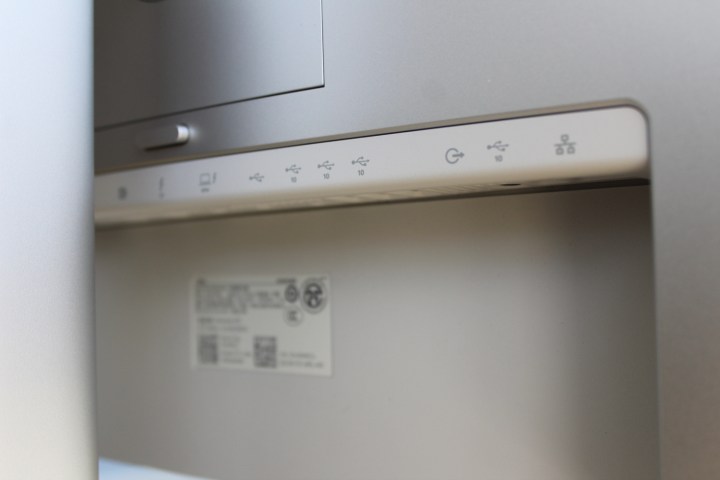
Dell puts the name “Thunderbolt Hub” right in the name of the product, so you can expect there to be a healthy number of ports. The U3425WE does not disappoint in that regard. It has just about everything you could need and more. That includes a DisplayPort 1.4, an HDMI 2.1, a Thunderbolt 4 USB-C with 90 watts of power delivery, a USB-C 3.2 Gen 2 upstream, four USB-A 3.2 Gen 2 downstream, a USB-C 3.2 Gen 2 downstream, a USB-A 3.2 Gen 2, a 3.5mm headphone jack, and an RJ45 Ethernet jack.
A large part of what you’re paying for here is the ability to plug in all your external devices, peripherals, and accessories into the back of the monitor, with just a single cable connection to your PC. If you work off a laptop, this kind of setup is ideal. Throw in the simple but practical cable management solution in the stand, and you’ve got a very tidy desk.
Considering the extra fee, of course, you should really need to evaluate if you will put this to full use. If your setup is relatively basic, it might not make sense to fork out the extra cash required for this amount of connectivity. Dell has two cheaper ultrawide monitors with a similar you’ll want to consider first.
The only thing it’s really missing is the pop-down, front-facing ports of the UltraSharp 6K, which are super convenient for quick access. Along with those ports, the monitor also features a KVM switch, letting you connect to two sources, and easily switch between the two, all using the same accessories. Again, this isn’t something everyone needs, and you’re definitely paying extra for it. For those who would actually use it, though, it’s a must-have feature.
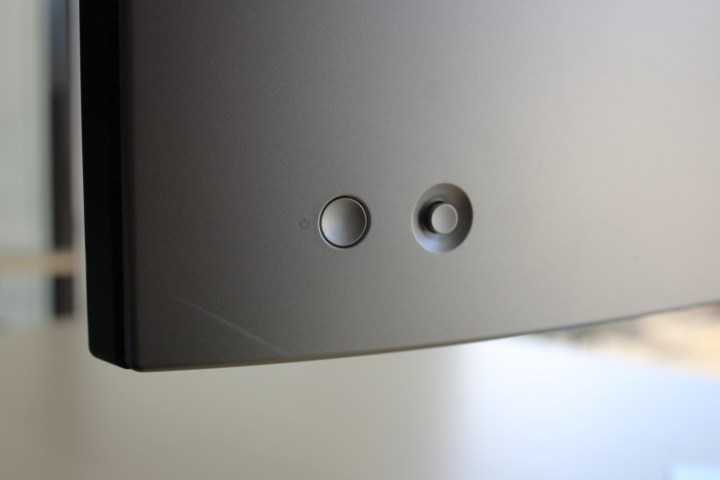
The controls are funneled through a single joystick located on the right side of the monitor’s frame. You’ll also find a dedicated power button next to it. It uses the typical Dell OSD (on screen display), which isn’t pretty, but is fairly functional. You’ll have access to the different Preset modes here, including Standard, Movie, and Game, as well as individual settings for adjusting color temperature or color space. As I’ll discuss later, you can also adjust brightness and contrast here, in addition to toggling off auto-brightness or auto-color tuning.
Image quality
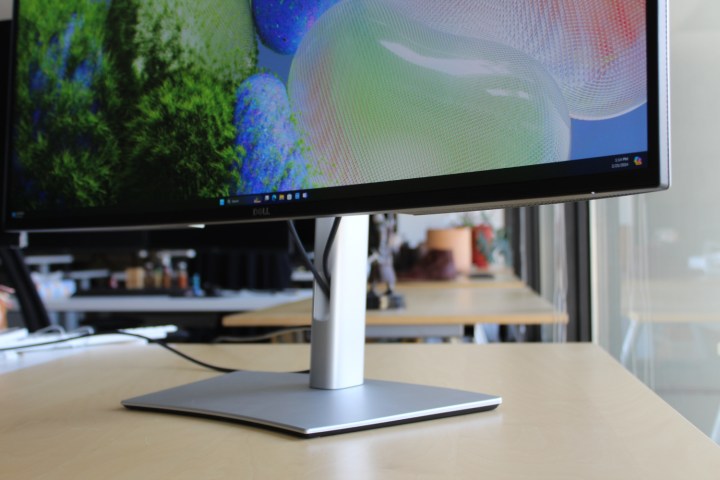
Unlike some of its competitors, Dell has stayed away from adopting newer panel types, such as mini-LED or OLED. It’s ironic, as its gaming brand Alienware has been on the forefront of these highly improved monitor types, some of which are cheaper than this UltraSharp. The Alienware 34 QD-OLED, for example, sells for just $800 right now. Obviously, that’s a different target audience and use case, but it’s hard not to make the comparison.
Dell has an alternative to these panel types however, which is called IPS Black. It’s a partnership made with LG Display that attempts to boost contrast and colors to compete with some of these other panel types. Dell claims the U3425WE can hit a contrast ratio of 2,000:1 and 300 nits of brightness, as well as viewing angles of 178 degrees. That’s not quite OLED quality, of course, but it claims to significantly enhance the contrast of a conventional IPS.
If you do serious content creation with this monitor, you’ll want to calibrate it first.
When you boot up the monitor, the default setting for contrast is at 75%. At that level, I was able to measure a contrast ratio of 1,750:1. Set to 100% within the settings, I was able to get it slightly closer to 2,000:1, but that tanked the color accuracy. In theory, you can always max at the contrast when you’re consuming content and drop it to 75% when you’re creating content. Either way, I wasn’t ever able to actually achieve 2,000:1. On top of that, keep in mind that this is a matte screen, meaning there’s an anti-glare coating over it to reduce reflections. I prefer a glossy screen, especially if contrast is supposed to be emphasized, as the coating obscures some of the impact of that extra contrast.
But really, if you’re planning to do serious content creation on this monitor, you’ll need to calibrate it yourself. Using my Spyder X2 Ultra, I was able to calibrate the screen to correct the color accuracy down to a Delta-E of just 0.65 down from a not-so-great 2.17. The color coverage is good, however, with 100% sRGB, 88% AdobeRGB, and 94% P3.
The resolution at this size isn’t super sharp, with a pixel density of 109 pixels per inch. Just as a point of comparison, the entry-level Dell XPS 13 (with a 1900 x 1200 resolution) is 35% sharper. Obviously, that’s not a fair comparison to make because of how much bigger the screen is, but it’s worth mentioning if you’re coming from working on a laptop. 3440 x 1440 has become the standard for 34-inch ultrawide screens, which is why the higher pixel density of 4K 27-inch or 32-inch screens is still preferred by some.
For what it’s worth, the UltraSharp 32 4K U3223QE, a monitor we gave a glowing review to, costs just $870 right now. The U3425WE still has a lower pixel density than that laptop, but comes considerably closer. The U3223QE is an interesting point of comparison, actually, because it’s significantly brighter, can actually hit the 2,000:1 contrast ratio, and comes with significantly better out-of-box color accuracy.
Refresh rate
I’ve gone this far without talking much about this monitor’s key feature, which is its 120Hz refresh rate. I’ve written extensively about this trend already, but I’ll say it again: it’s fantastic to see 120Hz refresh rates on non-gaming displays. It came to laptops first, even making it to the Dell XPS 13 and 14 this year. Notably, it’s even available in the base configurations of the XPS 13, marking a big change from the 60Hz panels in all XPS laptops in the past.
But with monitors, there are far less features that draw attention, making the difference between 60Hz and 120Hz more pronounced from a marketing standpoint. I suppose that’s how Dell gets to charging this much just for an upgrade in refresh rate. Obviously, the change in refresh rate isn’t as noticeable in productivity as it is in games.
This difference can be felt when you switch between a 60Hz screen on the Apple Studio Display, for example, and something faster. The jump from 60Hz to 120Hz dramatically reduces motion blur, making even just moving the cursor across the screen feel smoother.
The higher refresh rate also means you can play games decently on the U3425WE. That’s a pretty big deal. While I would never buy this monitor first and foremost for gaming (especially at this price), being able to play some games on the side without being capped at 60Hz is an attractive proposition. The ultrawide form factor has become popular for gamers too, meaning this could easily double as a gaming display — if only it had support for FreeSync.
But again, there are cheaper options like 144Hz LG 38WN95C Ultrawide or even the 100Hz Samsung 34-inch ViewFinity CJ79.
Is it worth it?

When you consider the competition, Dell is charging higher prices here for its IPS Black contrast and excellent three-year warranty. The LG and Samsung options I listed above only come with one-year warranties, which is a bummer.
As for IPS Black, it’s true that you’re getting a decent increase in contrast here compared to a conventional IPS panel. That makes a difference, even if my unit never actually hit 2,000:1. It’s not as though that contrast is enough to make this a drool-worthy HDR panel by any means, and the color accuracy isn’t great out of the box for creative work. The Apple Studio Display isn’t an ultrawide obviously (and it’s even more expensive), but it delivers on out-of-the-box color accuracy, brightness, and pixel density.
It’s frustrating to compare this model to how good Alienware’s QD-OLED options are in this regard. Until we get OLED or mini-LED creative monitors that don’t scare people away, these IPS panels will always feels overpriced at full retail price. Again, consider the U3223QE, which was a stronger example of IPS Black and has already dropped over $300 from its original retail price.
Over time, I’m almost certain prices will come down on the U3425WE too, and if it dips a bit more, it’ll be a no-brainer. But even as is, this is a really solid monitor for those who are ultrawide-inclined, especially when you factor in its included industry-leading, three-year warranty.



